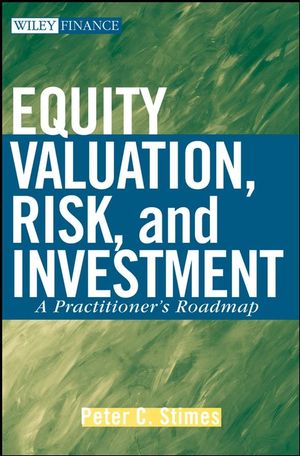Equity Valuation, Risk, and Investment: A Practitioner's RoadmapISBN: 978-0-470-22640-7
Hardcover
304 pages
February 2008
 |
||||||
Preface.
About the Author.
Chapter 1. Introduction.
Theoretical Precision or Theoretical Resilience?
Practical Difficulties as Well.
Overview of Our Analysis.
Chapter 2. Inflation Protected Bonds as a Valuation Template.
The Formulas Behind the Intuition.
TIPS versus Traditional Fixed-Rate Bonds – Measuring the Differences.
A Peek Ahead.
Chapter 3. Valuing Uncertain, Perpetual Income Streams.
The Mathematical Development of Un-leveraged Firm Valuation.
What Does the Valuation Formula Tell Us About Sensitivity to Inflation?
Sensitivity to Real Discount Rates and Growth Factors.
The Comparison with a Traditional Model of Firm Valuation.
Chapter 4. Valuing a Leveraged Equity Security.
Leverage in the Presence of Corporate Income Taxes.
From Theory to Practice – Valuing an Enterprise When the Discount Rates are Known
From Theory to Practice Part II – "Reverse Engineering" or Inferring Discount Rates from Observed Market Prices.
Chapter 4 Supplement: The Relationship between the Leveraged Equity Discount Rate and the Debt to Capital Ratio for Highly Leveraged Companies.
Chapter 5. Case Studies in Valuation during the Recent Decade.
Case 1: Coca-Cola ("KO").
Case 2: Intel ("INTC").
Case 3: Procter & Gamble ("PG").
Case 4: Enron ("ENE").
Tying Up the Package: The Practical Lessons from All Four Cases.
Chapter 6. The Treatment of Mergers and Acquisitions.
Generalizing from the P&G/Gillette Example.
Applicability of the Results under Alternate Merger Terms.
Analytical Postscript 1: Common Stock Buybacks and Issuances Outside the Merger Framework.
Analytical Postscript 2: A Brief Word on Executive Stock Option Grants.
Chapter 7. A Fair Representation? Broad Sample Testing Over a Ten-Year Market Cycle.
Sample Descriptive Data.
The Basic Valuation Results.
Predictive Strength of the Model, the Whole Period.
Predictive Strength of the Model, Sub-Periods.
Chapter 8. Price Volatility and Underlying Causes.
Deriving the Formula for Price Changes.
Translating the Price Change Formula into Volatility Estimates.
Digression: The Impact of Debt Leverage on Equity Volatility.
Obtaining the Volatility of the Underlying Variables.
Chapter 9. Constructing Efficient Portfolios.
Extracting Expected Equity Returns from Observed Price/Earnings Ratios – Part I.
Extracting Expected Equity Returns from Observed Price/Earnings Ratios – Part II.
Extracting Expected Equity Returns from Observed Price/Earnings Ratios – Part III.
Creating Efficient Portfolios – The Unconstrained Case.
Creating Efficient Portfolios – The Case Where Asset Weights Are Required To Be Non-Negative.
Computing the Variance/Covariance Matrix Inputs.
Chapter 10. Selecting among Efficient Portfolios; Making Dynamic Rebalancing Adjustments.
Reconciling Portfolio Desirability and Feasibility.
Turning Theory into Easily Calculated Results.
Adjusting for Changes in Long-Term Expected Returns on Common Equity.
Adjusting for More General Changes in Risk-Adjusted Expected Returns.
Recapitulation and an Important Caveat.
Chapter 11. How Did We Arrive Here Historically? Where Might We Go Prospectively?
The Next Crises of Confidence.
Some Answers Begin to Emerge.
What if Everyone Followed this Type of Model and Investing?
The Next Steps.
Appendix A. Mathematical Review of Growth Rates for Earnings, Dividends, and Book Value per Share.
Constant Growth Rate Characterization.
Transition from One Long-Term Growth Rate to Another.
Focus on Share Growth Impacts.
Appendix B. Sustainable and Non-Sustainable Inflation Rates.
The Impact of Monetary Policy and Interest Rates on Price Level Changes.
The Impact of "Real Shocks" on Measured Price Level Changes.
Drawing Correct Inferences.
Appendix C. Deriving the "Equity Duration" Formula.
Appendix D. The Traditional Growth/Equity Valuation Formula.
Appendix E. Adjustments Required to the Traditional Growth/Equity Valuation Formula in Order to Preserve Inflation Neutrality.
Appendix F. Brief Recapitulation of the Miller 1977 Capital Structure Irrelevance Theorem.
Appendix G. Time Series Charts of Un-leveraged, Inflation Adjusted Discount Rate Estimates.
Appendix H. Comparison of Volatility of Pre-Tax and After-Tax Income.
Appendix I. Relationship between Observed P/E Ratios and Nominal Interest Rates.
Appendix J. Additional Background on Mathematical Optimization Subject to Constraint Conditions.
Appendix K. Derivation of Asset Class Covariances.
Appendix L. Expected Return and Variance/Covariance Inputs Underlying Chapter 9 and Chapter 10 Portfolio Examples.
Bibliography.
Index.



